各向同性湍流的精确统计理论
- 格式:pdf
- 大小:308.81 KB
- 文档页数:10
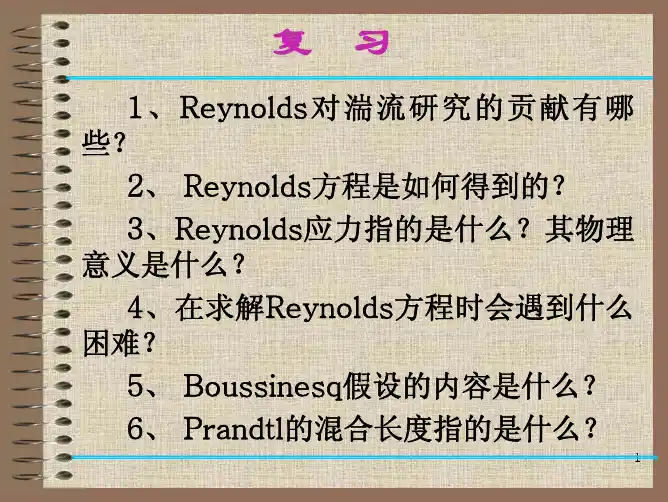
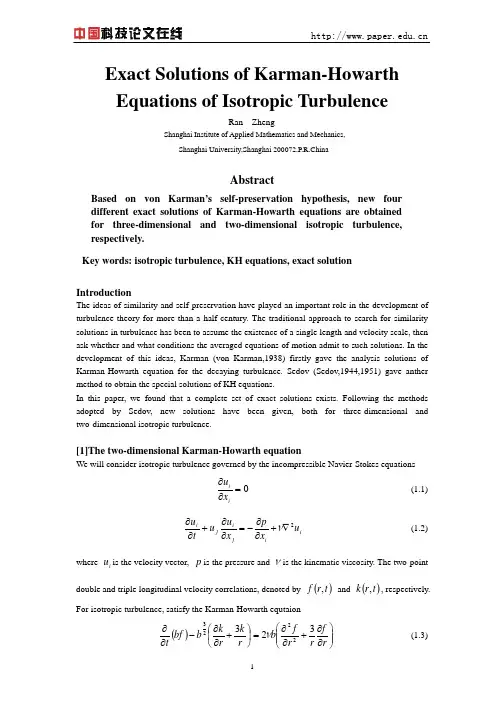
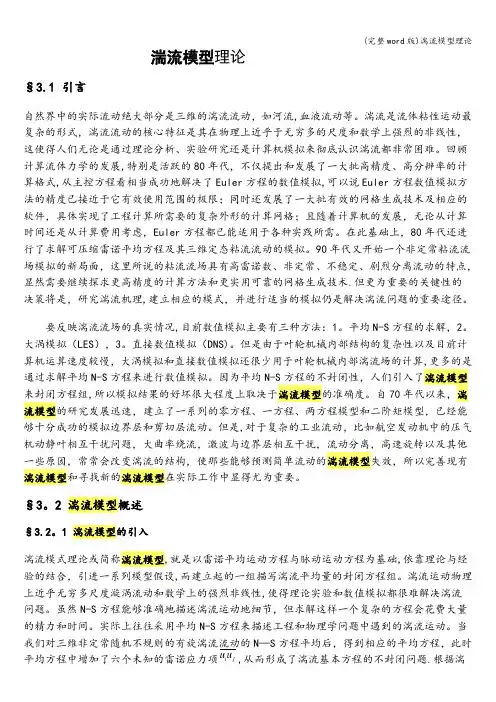
湍流模型理论§3.1 引言自然界中的实际流动绝大部分是三维的湍流流动,如河流,血液流动等。
湍流是流体粘性运动最复杂的形式,湍流流动的核心特征是其在物理上近乎于无穷多的尺度和数学上强烈的非线性,这使得人们无论是通过理论分析、实验研究还是计算机模拟来彻底认识湍流都非常困难。
回顾计算流体力学的发展,特别是活跃的80年代,不仅提出和发展了一大批高精度、高分辨率的计算格式,从主控方程看相当成功地解决了Euler方程的数值模拟,可以说Euler方程数值模拟方法的精度已接近于它有效使用范围的极限;同时还发展了一大批有效的网格生成技术及相应的软件,具体实现了工程计算所需要的复杂外形的计算网格;且随着计算机的发展,无论从计算时间还是从计算费用考虑,Euler方程都已能适用于各种实践所需。
在此基础上,80年代还进行了求解可压缩雷诺平均方程及其三维定态粘流流动的模拟。
90年代又开始一个非定常粘流流场模拟的新局面,这里所说的粘流流场具有高雷诺数、非定常、不稳定、剧烈分离流动的特点,显然需要继续探求更高精度的计算方法和更实用可靠的网格生成技术.但更为重要的关键性的决策将是,研究湍流机理,建立相应的模式,并进行适当的模拟仍是解决湍流问题的重要途径。
要反映湍流流场的真实情况,目前数值模拟主要有三种方法:1。
平均N-S方程的求解,2。
大涡模拟(LES),3。
直接数值模拟(DNS)。
但是由于叶轮机械内部结构的复杂性以及目前计算机运算速度较慢,大涡模拟和直接数值模拟还很少用于叶轮机械内部湍流场的计算,更多的是通过求解平均N-S方程来进行数值模拟。
因为平均N-S方程的不封闭性,人们引入了湍流模型来封闭方程组,所以模拟结果的好坏很大程度上取决于湍流模型的准确度。
自70年代以来,湍流模型的研究发展迅速,建立了一系列的零方程、一方程、两方程模型和二阶矩模型,已经能够十分成功的模拟边界层和剪切层流动。
但是,对于复杂的工业流动,比如航空发动机中的压气机动静叶相互干扰问题,大曲率绕流,激波与边界层相互干扰,流动分离,高速旋转以及其他一些原因,常常会改变湍流的结构,使那些能够预测简单流动的湍流模型失效,所以完善现有湍流模型和寻找新的湍流模型在实际工作中显得尤为重要。
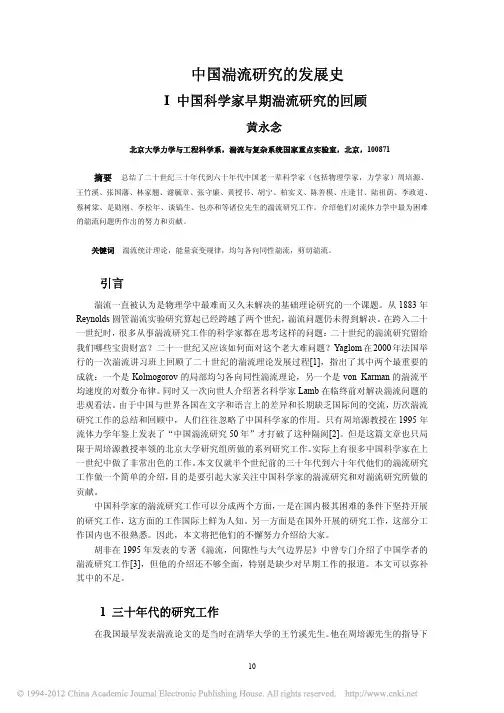
中国湍流研究的发展史I 中国科学家早期湍流研究的回顾黄永念北京大学力学与工程科学系,湍流与复杂系统国家重点实验室,北京,100871摘要总结了二十世纪三十年代到六十年代中国老一辈科学家(包括物理学家,力学家)周培源、王竹溪、张国藩、林家翘、谢毓章、张守廉、黄授书、胡宁、柏实义、陈善模、庄逢甘、陆祖荫、李政道、蔡树棠、是勋刚、李松年、谈镐生、包亦和等诸位先生的湍流研究工作。
介绍他们对流体力学中最为困难的湍流问题所作出的努力和贡献。
关键词湍流统计理论,能量衰变规律,均匀各向同性湍流,剪切湍流。
引言湍流一直被认为是物理学中最难而又久未解决的基础理论研究的一个课题。
从1883年Reynolds圆管湍流实验研究算起已经跨越了两个世纪,湍流问题仍未得到解决。
在跨入二十一世纪时,很多从事湍流研究工作的科学家都在思考这样的问题:二十世纪的湍流研究留给我们哪些宝贵财富?二十一世纪又应该如何面对这个老大难问题?Yaglom在2000年法国举行的一次湍流讲习班上回顾了二十世纪的湍流理论发展过程[1],指出了其中两个最重要的成就:一个是Kolmogorov的局部均匀各向同性湍流理论,另一个是von Karman的湍流平均速度的对数分布律。
同时又一次向世人介绍著名科学家Lamb在临终前对解决湍流问题的悲观看法。
由于中国与世界各国在文字和语言上的差异和长期缺乏国际间的交流,历次湍流研究工作的总结和回顾中,人们往往忽略了中国科学家的作用。
只有周培源教授在1995年流体力学年鉴上发表了“中国湍流研究50年”才打破了这种隔阂[2]。
但是这篇文章也只局限于周培源教授率领的北京大学研究组所做的系列研究工作。
实际上有很多中国科学家在上一世纪中做了非常出色的工作。
本文仅就半个世纪前的三十年代到六十年代他们的湍流研究工作做一个简单的介绍,目的是要引起大家关注中国科学家的湍流研究和对湍流研究所做的贡献。
中国科学家的湍流研究工作可以分成两个方面,一是在国内极其困难的条件下坚持开展的研究工作,这方面的工作国际上鲜为人知。
![[理学]第七章第四节局地均匀各向同性湍流](https://uimg.taocdn.com/7f508498cd22bcd126fff705cc17552707225e80.webp)
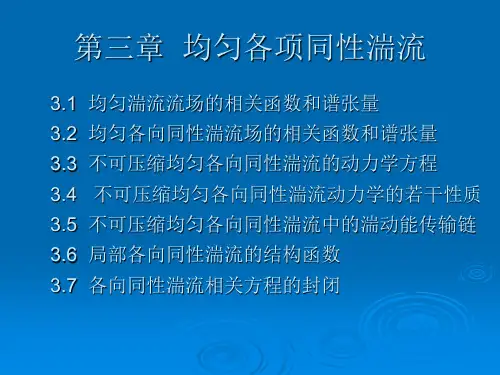
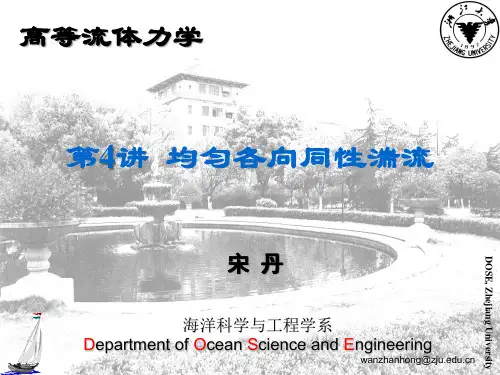
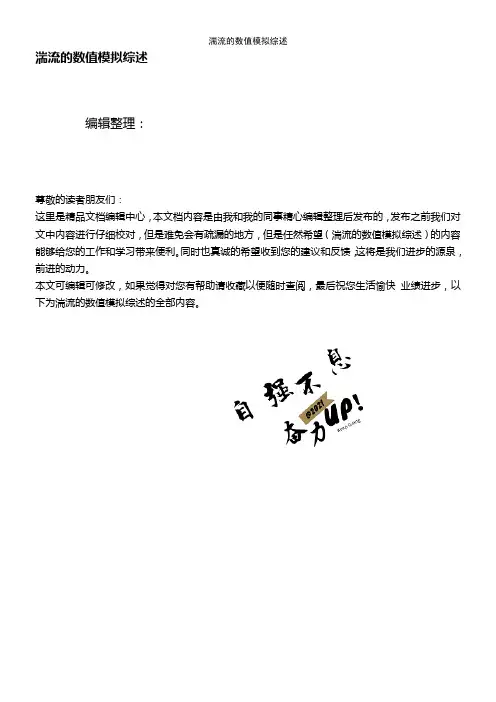
湍流的数值模拟综述编辑整理:尊敬的读者朋友们:这里是精品文档编辑中心,本文档内容是由我和我的同事精心编辑整理后发布的,发布之前我们对文中内容进行仔细校对,但是难免会有疏漏的地方,但是任然希望(湍流的数值模拟综述)的内容能够给您的工作和学习带来便利。
同时也真诚的希望收到您的建议和反馈,这将是我们进步的源泉,前进的动力。
本文可编辑可修改,如果觉得对您有帮助请收藏以便随时查阅,最后祝您生活愉快业绩进步,以下为湍流的数值模拟综述的全部内容。
湍流的数值模拟一、引语流体的流动形态分为湍流与层流。
而层流是流体的最简单的一种流动状态。
流体在管内流动时,其质点沿着与管轴平行的方向作平滑直线运动。
此种流动称为层流或滞流,亦有称为直线流动的.流体的流速在管中心处最大,其近壁处最小。
管内流体的平均流速与最大流速之比等于0.5,根据雷诺实验,当雷诺准数引Re<2320时,流体的流动状态为层流.当雷诺数Re〉2320时,流体流动状态开始向湍流态转变,湍流是一种很复杂的流动状态,是流体力学中公认的难题。
自从19世纪末O.Reynolds提出湍流的统计理论以来,已经有一个多世纪了,经过几代科学家的努力,湍流研究取得很大进展,但是仍然不能满足工程应用的需要,以至于经常有悲观的论调侵袭湍流研究。
为什么湍流问题没有圆满地解决会受到如此关注呢?因为湍流是自然界和工程中十分普遍的流动现豫,对于湍流问题的正确认识和模化直接影响到对自然环境的预测和工程的质量.例如,当前影响航天器气动力和气动热预测准确度的主要障碍是缺乏可靠的湍流模型。
和其他一些自然科学的准题不同,解决湍流问题具有迫切性。
湍流运动的最主要特征是不规则性,这是大家公认的。
对于湍流不规则性的深入认识,是一百多年来湍流研究的上要成就之一。
早期的科学家认为,像分子运动一样,湍流是完全不规则运动。
类似于分子运动产生黏性,湍流的耗散可以用涡黏系数来表述。
20世纪初,一些杰出的流体力学家,相继对涡黏系数提出各种流体力学的模型,如Taylor(1921年)的涡模型,Praudtl(1925年)的混合长模型和von Karman (1930年)相似模型等。
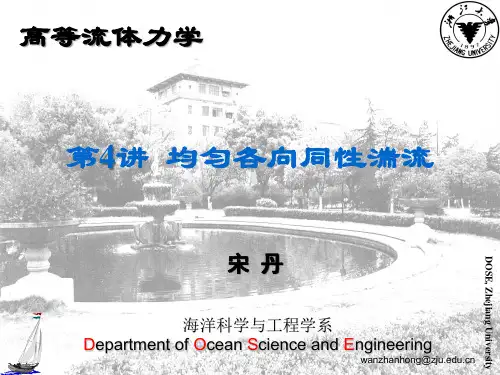

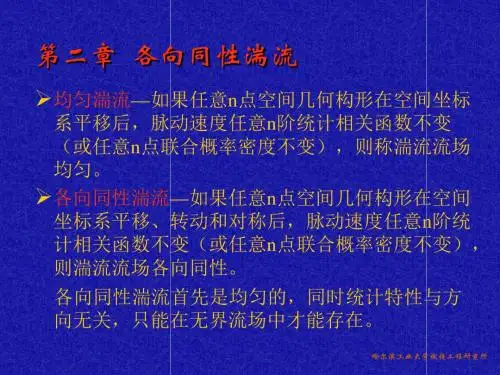
湍流理论发展概述一、湍流模型的研究背景自然环境和工程装置中的流动常常是湍流流动,模拟任何实际过程首先遇到的就是湍流问题,而湍流问题本身又是流体力学理论上的难题。
对于某些简单的均匀时均流场,如果湍流脉动是各向均匀及各向同性的,可以用经典的统计理论来分析,但实际上的湍流往往是不均匀的,这就给理论分析带来了极大地困难。
这也就引发了对湍流过程进行模拟的想法。
对湍流最根本的模拟方法是在湍流尺度的网格尺寸内求解瞬态的三维N-S 方程的全模拟方法,此时无需引进任何模型。
然而由于计算方法及计算机运算水平的限制,该种方法不易实现。
另一种要求稍低的方法是亚网格尺寸度模拟即大涡模拟(LES),也是由N-S方程出发,其网格尺寸比湍流尺度大,可以模拟湍流发展过程的一些细节,但由于计算量仍然很大,只能模拟一些简单的情况,直接应用于实际的工程问题也存在很多问题[1]。
目前数值模拟主要有三种方法:1.平均N-S方程的求解,2.大涡模拟(LES),3.直接数值模拟(DNS),而模拟的前提是建立合适的湍流模型。
所谓的湍流模型,就是以雷诺平均运动方程与脉动运动方程为基础,依靠理论与经验的结合,引进一系列模型假设,而建立起的一组描写湍流平均量的封闭方程组。
目前常用的湍流模型可根据所采用的微分方程数进行分类为:零方程模型、一方程模型、两方程模型、四方程模型、七方程模型等。
对于简单流动而言,一般随着方程数的增多,精度也越高,计算量也越大、收敛性也越差。
但是,对于复杂的湍流运动,则不一定。
湍流模型可根据微分方程的个数分为零方程模型、一方程模型、二方程模型和多方程模型。
这里所说的微分方程是指除了时均N-S 方程外,还要增加其他方程才能是方程封闭,增加多少个方程,则该模型就被成为多少个模型。
二、基本湍流模型常用的湍流模型有:零方程模型:C-S模型,由Cebeci-Smith给出;B-L模型,由Baldwin-Lomax 给出。
一方程模型:来源由两种,一种从经验和量纲分析出发,针对简单流动逐步发展起来,如Spalart-Allmaras(S-A)模型;另一种由二方程模型简化而来,如Baldwin-Barth(B-B)模型。
湍流理论研究进展简介摘要:湍流的机理使用许多方法从不同的侧面予以揭示,但问题的解决仍很漫长。
由于一些新技术在湍流实验方面的广泛实践和应用,人们开始对湍流整体的认识更加深入,从而揭示出新的实验现象、验证已有的理论成果。
关键词:湍流;研究进展;N-S方程;数值模拟湍流行为的有限维非线性动力系统的渐近解接近不规则性,但是存在较大困难的是,从理论上把有限维非线性动力系统理论推广到属于无限维非线性动力系统的偏微分方程的初边值问题。
但是在湍流研究的实践中,在大雷诺数的情况下,N-S方程的初边值问题,渐近解的不规则性。
其中一个证据是利用近代先进的计算机来数值求解N-S方程的实验。
在一些简单几何边界流动的数值实验中,不规则解在时间、空间上得以模拟,并且可以得到由这些解的系综统计或时间平均中得到和物理实验相同的统计结果,其次一个证据是Lorenz的奇怪吸引子解,在N-S方程有限维近似解中发现,当雷诺数很大时,方程存在长时间的不规则振荡解,这种解被称为奇怪吸引子,正是Lorenz的研究才开启了近代混沌理论研究的先河。
一、研究进展及启示在湍流理论中,Reynolds提出了两个理论,一个理论是把流动变成脉动部分和平均部分,另一个理论是流动状态稳定性的判断依据[1]。
第二个理论的判断依据是:(1)。
一些具有关联形式(2)的附加项出现在平均运动方程中,则湍流应力张量的分量是;因此,在平均部分中不可压缩流体的所有应力分量可以表示为:(3)在湍流理论的研究过程中,出现了许多常见问题:对于具有变化物理特性的系统,如何确定(3)中的物理参量,;在层流流动中存在有稳定性问题,不可压缩流体运动在确定临界雷诺数的过程中表现出来的不确定性问题,层流转变成湍流的原理问题,这是由于该不可压缩流体存在着一个变换区域,该变换区域是稳定的层流变换成表征掺混现象的平稳湍流;由于出现表观湍流应力张量的分量导致雷诺方程的不封闭问题,有关的效应在湍流扰动的影响下出现同介质物理性质脉动;导电介质的湍流与电磁场之间的相互影响;在湍流流动的边界条件上,尤其是拥有一定的边界上,在距离固定壁面不远处存在有层流区间,该区间的下边界条件为流体附着在固定壁面上,而把湍流能量达到最大值作为其上边界条件。
浅谈湍封闭理论及其研究方法论文导读:湍流是海洋水体流动的主体。
湍流的统计理论的目标则是从最基本的物理守恒定律——N-S方程和连续性方程出发,探讨湍流的机理。
关键词:湍流,湍封闭模型,湍黏性系数,统计理论湍流是海洋水体流动的主体,早在十九世纪初期,水力学家们便发现,在不同条件下,流体质点的运动情况可能表现为两种不同的状态,一种是层流运动,一种是湍流运动。
湍应力的封闭是流体动力学的一个重要课题,也是三维浅海流体动力学的重要问题。
长期以来,浅海流体动力学模型均引入湍黏性系数将雷诺应力参数化,而多数为经验地给定湍黏性系数随深度的剖面。
经验地给定湍黏性系数给理论和数值计算带来了方便,但却把非线性的湍应力线性化了,同时对流场结构和湍应力大小也造成不同程度的误差。
迄今,更复杂的确定湍黏性系数的湍封闭模型已应用于浅海流体动力学,按引入的偏微分方程的个数,它们可分为零方程模型(如Prandtl模型)、一方程模型(如K模型)、二方程模型(如模型)和多方程模型。
最早关于湍流的理论是1883年英国科学家Reynolds通过实验建立起来的圆管内层流向湍流过渡的理论。
在其后的100多年里人们已经从半经验分析方法到统计学方法提出了各种描述湍流的理论。
湍流是一种高频随机运动,海水运动大多呈这一复杂形式。
湍流对海水的动量、热量和质量输运有重要贡献,对海水运动速度、温盐特性及水中溶解态、颗粒态物质的分布有显著影响。
描述端流平均运动的Reynods方程是不封闭的,需要以一定的模型将湍流的宏观效应刻划出来.随着计算机的产生,使得详细的模拟湍流流动成为可能。
70年代,计算流体力学的发展促进了湍流模拟的发展.从二维正压流动的数值摸拟开始,出现了许多数值模式,如ADI 法、有限元法、谱方法等,此时人们将湍流问题线性化来简化问题。
随着研究问题的深入,人们认识到湍流在诸如海面的波浪破碎、气泡生成、兰米尔环流,海洋内部的双扩散、跃层生衰内渡破碎等方面,起了举足轻重的作用。
Exact statistical theory ofisotropic turbulence1Ran zhengShanghai Institute of Applied Mathematics and Mechanics,Shanghai University, Shanghai 200072,P.R.ChinaAbstractSome physically significant consequences of recent advances in the theory ofself-preserved homogenous statistical solutions of the Navier-Stokes equationsare presented.Keywords: isotropic turbulence, Karman-Howarth equation, exact solution1 IntroductionHomogeneous isotropic turbulence is an idealized concept of turbulence assumed to be governed by a statistical law that is invariant under arbitrary translation (homogeneity), rotation or reflection (isotropic) of the coordinate system. This is an idealization of real turbulent motions, which are observed in nature or produced in a laboratory have much more complicated structures. This idealization was first introduced by Taylor (1935) to the theory of turbulence and used to reduce the formidable complexity of statistical expression of turbulence and thus make the subject feasible for theoretical treatment. Up to the present, a large amount of theoretical work has been devoted to this rather restricted kind of turbulence. Remarkable progress has been achieved so far in discovering the various nature of turbulence, but nevertheless our understanding of the fundamental mechanics of turbulence is still partial and unsatisfactory (Tatsumi, 1980)The assumption of self-preservation permits an analytical determination of the energy decay in isotropic turbulence. This idea of similarity and self-preservation has played an important the development of turbulence theory for more than a half-century. The traditional approach to search for similarity solutions in turbulence has been assume the existence of a single length and velocity scale, then ask whether and under what conditions the turbulent motions admit to such solutions. Excellent contributions had been given to this direction. Von Karman and Howarth (1938) firstly deduced the basic equation, also presented a particular set of solutions of Karman-Howarth equation for the final decaying turbulence. Later on, two Russian authors, Loitsiansky (1939) and Millionshtchikov (1941), have each discussed the solutions of Karman-Howarth equation which are obtained when the term describing the effect of the triple 1 National Natural Science Foundation of China (10272018, 10572083) velocity correlation is ignored. Their work is an extension of the “small Reynolds number” solution first put forward by von Karman and Howarth.H.Dryden (1943) gave a useful review on this subject. Great deep research on the solutions of Karman-Howarth equation was conducted by Sedov (1944). He showed that one could use the separability constraint to obtain the analytical solution of Karman-Howarth equation. Sedov’s solution could be expressed in terms of the confluent hypergeometric function. Batchelor (1948), who was also the first to carry out a detailed study of this problem, based his analysis on the assumption that the Loitsianskii integral is a dynamic invariant- a widely accepted hypothesis that was later discovered to be invalid. Batchelor conclude that the only complete self-preserving solution that was internally consistent existed at low turbulence Reynolds numbers where the turbulent kinetic energy consistent with the final period of turbulent decay. Batchelor (1948) also found a self-preserving solution to the Karman-Howarth equation in the limit of infinite Reynolds numbers for which Loitsiansky’s integral was an invariant. Objections were later raised to the use of Loitsiansky’s integral as a dynamic invariant: at high Reynolds numbers this integral can be shown to be a weak function of time (see Proudman & Reid 1954 and Batchelor & Proudman 1956). Saffman (1967) proposed an alternative dynamic invariant which yields another power law decayin the infinite Reynolds numbers limit (see Hinze 1975). While the results of Batchelor and Saffman formally constitute complete self-preserving solutions to the inviscid Karman-Howarth equation, it must be kept in mind that they only exhibit partial self-preservation with respect to the full viscous equation. Recently, George (1992) revived this issue concerning the existence of complete self-preserving solutions in isotropic turbulence. In an interesting paper he claimed to find a complete self-preserving solution, valid for all Reynolds numbers. George’s (1992) analysis is based on the dynamic equation for the energy spectrum rather than on the Karman-Howarth equation. Strictly speaking, the solution presented by George was an anlternative self-preserving solution to that of Karman-Howarth and Batchelor since he relaxed the constraint that the triple longitudinal velocity correlation be self-similarity in the classical sense. Speziale and Bernard (1992) reexamined this issue form a basic theoretical and computational standpoint. Several interesting conclusions had been drawn from their analysis.From the long history stories, we know that: Decaying homogeneous and isotropic turbulence is one of the most important and extensively explored problems in fluid dynamics and a central piece in the study of turbulence. Despite all the effort, a general theory describing the decay of turbulence based on the first principles has not yet been developed. (Skrbek and Steven R.Stalp, 2000). It thus appears that the theory of self-preservation in homogeneous turbulence has many interesting features that have not yet been fully understood and are worth of further study. (see Speziale and Bernard ,1992,pp.665).This paper offers a unified investigation of isotropic turbulence, based on the exact solutions of Karman-Howarth equation. Firstly, we will point out that new complete solution set may be exist if we adopt the Sedov (1944) method. Based on the above finds, new results could be obtained for the analysis on turbulencefeatures, such as the scaling behaviour, the spectrum, and also the large scale dynamics.2 Self-preservation solution under Sedov’s separability constraintFor complete self-preserving isotropic turbulence, the Karman-Howarth equation will have a solution if Reynolds number based on the Taylor microscale is constant as first noticed by Dryden (1943). However, this equation also has solutions where Reynolds number based on the Taylor microscale is time dependents when separability is invoked. The separability condition implies that each side of the equation is equal to zero individually, yielding differential equations from which explicit solution for the correlation functions may be determined depending on the choice of parameters. These solutions were first discovered by Sedov (1944) and later compared with experimental data by Korneyev & Sedov (1976). Here, we will discuss the possible new complete solutions under Sedov’s separability constraint.The two-point double longitudinal velocity correlations read as ( named Sedov equation)02242122=+⎟⎟⎠⎞⎜⎜⎝⎛++f a d df a d f d ξξξξ (1) with boundary conditions ()10=f ,()0=∞f .In the following analysis, we introduce alternative two parameters denoted by σ,1a , here122a a =σ (2) The complete new set of the solution of the equation (1) with the boundary condition could be given as following :The first kind of solution :if 25=σ,thus ()214ξξa e f −= (3)The secondary kind of solution :if 45−=σκ,thus ()⎟⎠⎞⎜⎝⎛−=−2144,25,2521ξσξξa F e f a (4) The third kind of solution :if σκ−=45,thus ()⎟⎠⎞⎜⎝⎛=−2144,25,21ξσξξa F e f a (5) The forth kind of solution :if 45=σ,thus ()⎟⎠⎞⎜⎝⎛=−2144,23,4321ξξξa F e f a (6) where (z F ,,)γαis the confluent hypergeometric function and the definition of the existing parameter κwill be given appendix. From the asymptotic expansions and the limiting forms of the confluent hypergeometric function, we could deduce the existence conditions of these solutions :For all four kind of solutions :,01>a For the secondary kind of soultions :0>σ;For the third kind of solution :250<<σ; The details could be seen in appendix .A simple comparison shows that the special solution found by Sedov (1944) is belonging to the secondary kind of our new set of solution.3 Some theoretical results based on the exact solutionsA unified investigation of isotropic turbulence, based on the above exact solutions of Karman-Howarth equation could be given. New results could be obtained for the analysis on turbulence features, such as the scaling behaviour, the spectrum, and also the large scale dynamics, some results could be seen in the following references [19,20,21,22] .References[1]Bareenblatt,G.J.& Garilov,A.A. 1974. Sov. Phys. J. Exp. Theor. Phys. 38,399-402.[2]Batchelor,G.K. 1948.Q. Appl. Maths. 6,97-116.[3]Batchelor, G.K. 1953 The Theory of Homogeneous Turbulence Turbulence. Cambrige University Press.[4]Batchelor,G.K. & Proudman,I. 1956. Phil. Trans. R. Soc. Lond. A.248,369-405. [5]Dryden,J.L. 1943. Q. Appl. Maths. 1,7-42.[6]George,W.K. 1992. Phys. Fluids A 4,1492-1509.[6]Hinze,J.O. 1975 Turbulence. McGraw-Hill.[7]Karman,T.Von & Howarth,L. 1938. Proc. R. Soc. Lond. A164,192-215.[8]Korneyev & Sedov, L.I. 1976. Fluid Mechanics-Soviet Research 5,37-48.[9]Lesieur,M. 1990 Turbulence in Fluids, 2nd Edn. Martinus Nijhoff.[10]Lin,C.C. 1948. Proc. Natl. Acad. Sci. 34,540-543.[11]Millionshtchikov, M. 1941. Dokl. Akad. Nauk SSSR 32,615-618.[12]Monin,A.S. & Yaglom,A.M. 1975 Statistical Fluid Mechanics: Mechanics of Turbulence, vol.2, MIT Press.[13]Proundman, I. & Reid, W. H. 1954. Philos. Trans. R. Soc. London, A 247,163-189.[14]Saffman,P.G. 1967. J. Fluid Mech. 27,581-594.[15]Sedov, L.I. 1944. Dokl.Akad.Nauk SSSR 42,116-119.[16]Speziale,C.G. & Bernard, P.S. 1992. J. Fluid Mech. 241,645-667.[17]Skbek,L. & Steven, R.S. 2000. Phys. Fluids 12,1997-2019.[18]Tatsumi, T. 1980. Advances in Applied Mechanics,39-133.[19]Ran zheng, Exact solutions of Karman-Howarth equation. -200510-311[20]Ran zheng, Scales and their interaction in isotropic turbulence. -200510-205.[21]Ran zheng, Dynamic of large scales in isotropic turbulence. -200509-230.[22]Ran zheng, On von Karman’s decaying turbulence theory. -200511-233.Appendix: Solutions of the correlation coefficientsThe ideas of similarity and self-preservation were firstly introduced by von Karman (1938). Following the methods adopted by Sedov (1944,1951), the two point double longitudinal velocity correlations satisfied02242122=+⎟⎟⎠⎞⎜⎜⎝⎛++f a d df a d f d ξξξξ (1) with the boundary condition()10=f()0=∞fThe complete solution are given in this paper, these are :When 25=σ,()214ξξae f −= When 45−=σκ,()⎟⎠⎞⎜⎝⎛−=−2144,25,2521ξσξξa F e f a When σκ−=45,()⎟⎠⎞⎜⎝⎛=−2144,25,21ξσξξa F e f a When 45=σ,()⎟⎠⎞⎜⎝⎛=−2144,23,4321ξξξa F e f a The detailed calculation is given as following:A lot of useful partial differential equations can be reduced to confluent hypergeometric equations. Let ()ςm k P ,is the solution of Whittaker equation as that defined by Whittaker and Waston041412222=⎥⎦⎤⎢⎣⎡−++−+W m k d W d ςςς (2) where()()()()z h P e z z y m z f ,κβ= (3)After some reduction, the equation of ()z y reads()()02222=⋅+⎥⎦⎤⎢⎣⎡′++′′′−z y g dzdy z f z h h dz y d β (4) where()()12212g f z h h z z f f f g +⎟⎠⎞⎜⎝⎛′+′′′+++′+′′−′=ββββ ⎟⎟⎠⎞⎜⎜⎝⎛−+−⎟⎠⎞⎜⎝⎛′=4412221h h m h h g κ The solutions of above equation could be deduced in terms of Whittaker function. We discussed this equation in following special case:()λaz z f = (5)()λAz z h = (6) The equation under this condition reads as()0221122=+⎥⎦⎤⎢⎣⎡−−−+−z qy dzdy z z dz y d λλαβλ (7) where()()()2222222224124z m z A z A q −+++++⎟⎟⎠⎞⎜⎜⎝⎛−=−−λλββκλαβλαλλλThe solution of this equation is()()λκαβλAz P e z z y m z ,= (8)For isotropic turbulence, the corresponding parameters satisfied421=−−βλ (9) 11=−λ (10)221a =−λα (11) 04222=⎟⎟⎠⎞⎜⎜⎝⎛−A αλ (12) ()04122=⎟⎠⎞⎜⎝⎛−++m λλββ (13) ()222a A =+κλαβλ (14) Hence, we have2=λ (15)81a −=α (16) 25−=β (17) 43±=m (18) 41a A ±= (19) ⎭⎬⎫⎩⎨⎧−±=45212a a κ (20) From above analysis, we can introduce two parameters to classification turbulence, they are: 1212,a a a =σ。